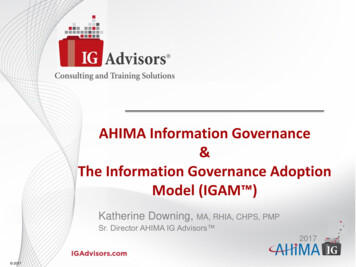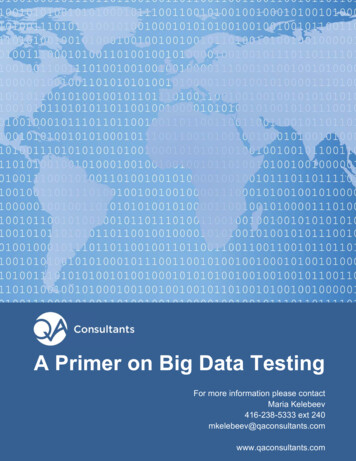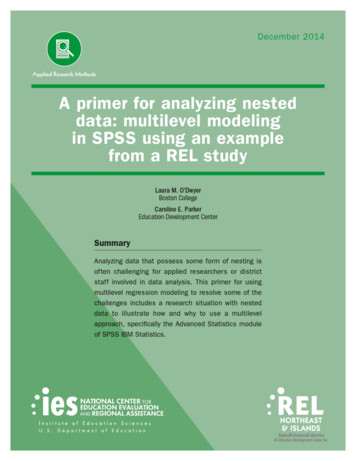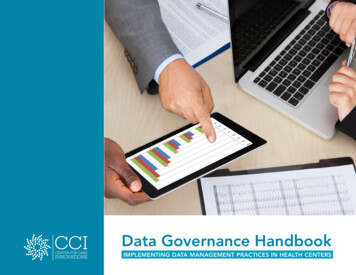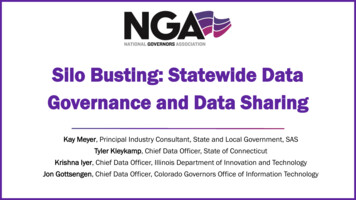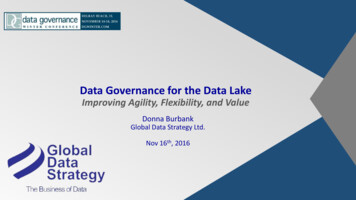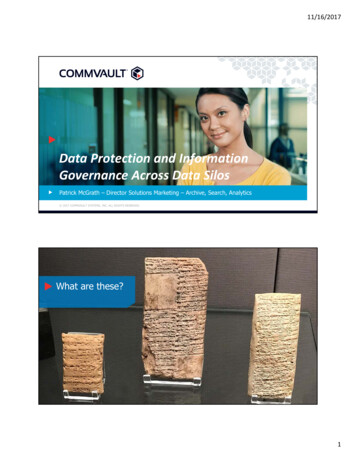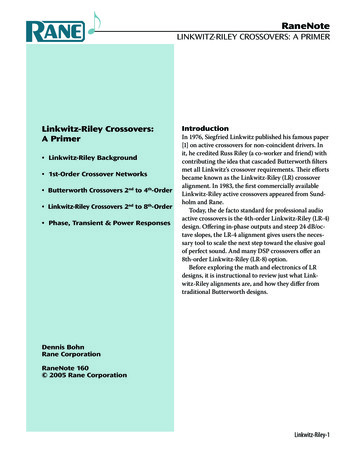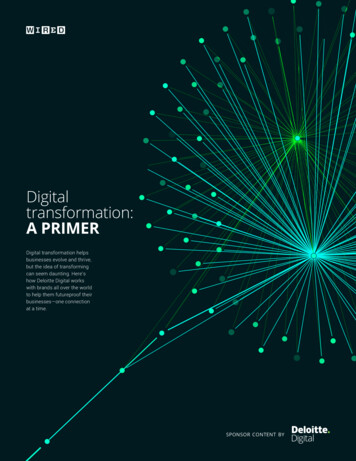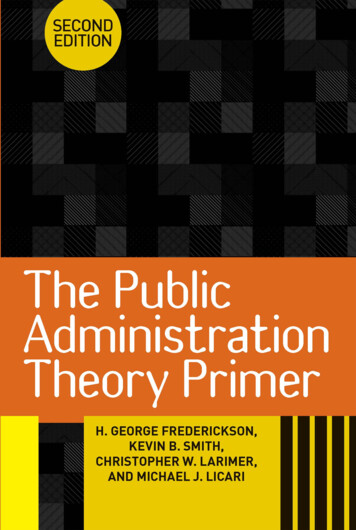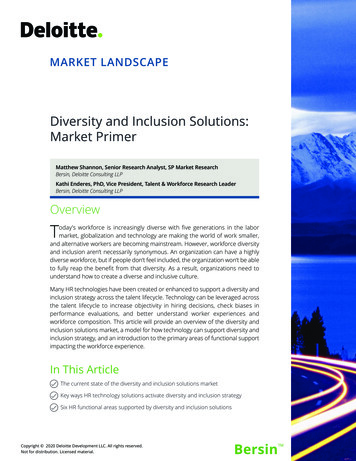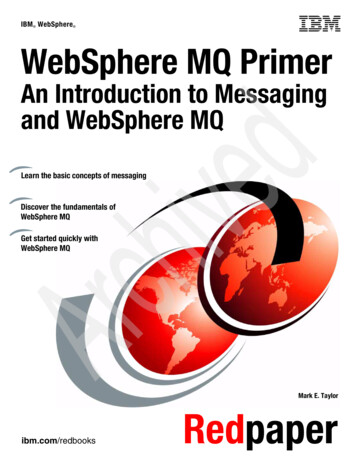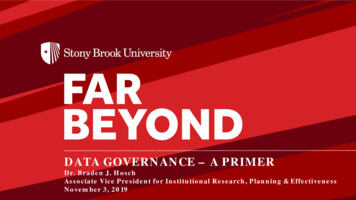
Transcription
DATA GOVERNANCE – A PRIMERDr. Braden J. HoschAssociate Vice President for Institutional Research, Planning & EffectivenessNovember 3, 20191
OverviewData governance concepts and major aspectsSelling data governance to senior leadershipCharacteristics of a data governance systemMaturity modelsChange management in a college or universityTechnological “solutions”2
Outcomes for workshop participantsDefine data governanceas an activity that centerson human behavior morethan dataDescribe majorcomponents of datagovernance activitiesArticulate challenges ontheir campus and howdata governance willaddress these challengesAssess their campusculture and organizationwith a data governancematurity model; selectand modify a datagovernance maturitymodel for their campusIdentify characteristics ofa data governancesystem; analyze wheretheir own institution hasgaps; and create anoutline for how datagovernance could fit intoexisting organizationalstructuresDiscuss how technologymay assist but notperform datagovernance; describemajor functions of datagovernance softwareapplications or “solutions”Explain principles ofchange management inhigher educationinstitutions and how theywill enable developmentof data governance ontheir campusesConstruct an action planfor next steps on theirown campus to advancedata governanceactivities3
What this workshop will not do Design your data governance system for you Promote specific technological solutions Prescribe specific functions, operations, or organization Identify how much money to spend4
WHAT IS DATA GOVERNANCE?5
Data Governance Definitions (Generic) “the execution and enforcement of authority over the management ofdata and data-related assets” - R. Seiner (2014) “specification of decision rights and an accountability framework toensure appropriate behavior in the valuation, creation, storage, use,archiving and deletion of information” - Gartner IT Glossary “a system of decision rights and accountabilities for information-relatedprocesses, executed according to agreed-upon models which describe whocan take what actions with what information, and when, under whatcircumstances, using what methods” – Data Governance Institute (2014)6
Data Governance Definitions from Universities “formalizes behavior around how data are defined, produced, used,stored, and destroyed in order to enable and enhance organizationaleffectiveness” – Stony Brook University (2016) “adds value to our administrative and academic data systems by theestablishment of standards that that promote data integrity and enablesstrategic integrations of information systems” – Vanderbilt University “the discipline which provides all data management practices with thenecessary structure, strategy, and support needed to ensure that data aremanaged and used as a critical University asset” – U of Rochester7
The 5-second elevator definitionDatagovernanceis a set of guidelinesfor how peoplebehave and makedecisions about data8
Master data management is often confused with datagovernanceMaster Data Management (MDM)Data Governance Comprehensive method to linkall critical data to a commonpoint of reference Example: All screens, documents andsystems showing a student’saddress derive from a commonlocation. Formalized system for howpeople make decisions aboutacquisition, production, storage,distribution, and analysis of data Example: Group decides on a definitionfor home address and agreeson a common source field9
Important characteristics of DG definitionsData governance ISData Governance IS NOT More about people andbehavior than data IT’s responsibility Solved by technology Equally applied across alldata assets A system that requires andpromotes shared agreement Formal (i.e. written down) Adds value by supportinginstitutional mission/goals10
Activity 1 – What data governance features do you have? List formal and informal structures you have for promotingdata lesResponsibilities11
WHY DO WE NEED DATA GOVERNANCE?12
Data governance is a strategic priorityProliferationof data andapplicationsPrivacyexpectations/ regulationsCloud datamobilityFair andethical use13
Justifications for Data GovernanceJustify data governance on your campusbased on:Value CostRisk14
Justifications for Data Governance - ValueEDUCAUSE identifies significant institutional value tohigher education institutions from data governance: Official vs. ad hoc data definitionsClear responsibilitiesCapacity for analyticsCompetitive advantageEDUCAUSE (2015). “The compelling case for data governance,” retrieved October 15, 2018 fromhttps://library.educause.edu/ /media/files/library/2015/3/ewg1501-pdf.pdf15
Justifications for Data Governance – Cost (1)A third of Fortune 100organizations will experience“an information crisis, due totheir inability to effectivelyvalue, govern and trust theirenterprise information.”Gartner. (2014). “Why data governance matters to your online business,” retrieved August 1, 2016from ta-governance-matters-to-your-online-business/16
Justifications for Data Governance – Cost (2)Poor data qualitycosts the USeconomy 3.1trillion every year 3.1TrillionIBM. (n.d.). “Extracting business value from the 4 V's of big data,” retrieved October 1, 2018 acting-business-value-4-vs-big-data17
Justifications for Data Governance – Cost (3)The average financial impact of poor data qualityon a typical businesses is 9.7 million per year.Opportunity costs, loss of reputation and lowconfidence in data may push these costs higher.Forbes (2017). “Poor-quality data imposes costs and risks on businesses,” retrievedOctober 22, 2018 from ses-says-new-forbes-insights-report18
Justifications for Data Governance - RisksFines Imposed by Federal Student AidFiscal YearClery/Part 86 Imposed FinesIPEDS Imposed FinesOther Imposed FinesTotal Imposed Fines2010 42,000 225,000 48,653,500 48,920,5002011 195,000 144,500 4,868,500 5,208,0002012 212,500 158,500 624,000 995,0002013 812,000 56,000 5,204,137 6,072,1372014 438,000 111,250 6,750 556,0002015 500,000 39,250 14,130,000 14,669,2502016 307,500 57,000 79,462,500 79,827,0002017 2,542,500 1,500 382,500 2,926,5002018 988,250 67,500 20,000 1,075,750Source: Postsecondary Education Participants System (PEPS)19
Data as an Asset By 2020, Gartner predicts that 10% of organizations will have ahighly profitable business unit specifically for productizing andcommercializing their information assets. By 2021 companies will be valued on their informationportfolios: “Those in the business of valuing corporateinvestments, including equity analysts, will be compelled toconsider a company’s wealth of information in properly valuingthe company itself.”20
Data as an Asset for UniversitiesGeneric ExampleAt Colleges & Universitiesweb sites grant access in exchange forpersonal data (email address, etc.) –these data have value and can beleveraged or even soldData are purchasedNames of prospective studentsLibrary databasesVarious datasets (U.S. News,Academic Analytics, etc.)Data are soldTo vendors for discounts or servicesLost data carry costsData breaches21
Who owns the data? Consider carefully use of the word “ownership” with data Often represents assignment of responsibility Connotes individual control and property vs. caretaking of sharedresource Institutions own the data Individuals provide stewardship22
Activity 2 - Why do we need data governance? Identify institution-specific examples that help make the casefor data governance Value – what could you do that you can’t do now? Costs – what costs are you incurring because data are not wellgoverned? Risks – what risks are you taking because data are not well governed?23
FEATURES OF DATA GOVERNANCE24
Key features of data governance systemsDocumentsGroups Charter / framework Principles & values Purpose & scope Roles & responsibilities Senior leadership[buy-in] Written & published policies Data dictionaries Communication strategies Data steward council(s)Individual roles Data stewards Data custodians/ caretakers Policy council Data users Information securitycouncil/program Positions/office tosupport DG25
Principles and valuesEstablishing principles and values for datagovernance assists with:Initial focusNavigatingdifficultsituations26
Principles of Data Governance (Generic)Consistency of data in itssourcing and in itsvocabulary, definitions,and taxonomiesQuality which isproactively assessed andstandards appliedResponsibility andaccountability definedacross the data lifecycleand recorded in theinformation asset registerBusiness alignment whichensures that data isregarded and treated as akey business assetAccess to relevant users,kept secure throughaccess controlProviding trusted insightSource: Carruthers, C. & Jackson, P. (2018). The chief data officer’s playbook, London: Facet, p. 14527
Principles and Values – ExampleUniversity of Wisconsin - MadisonAccountabilityDetermining who is responsible for the management of data at UW Madison as well asholding them to our outlined standards.AgilityAll of our processes should adapt when necessaryChange ManagementNew processes demand new and changing staff at UW. We’re committed to ensuringsmooth transitions and well informed decisions.ConsistencyAll decisions made will be applied consistently across campus.Metrics DrivenWe monitor ourselves against measurable goals on a regular basis and use the resultsto determine courses of action.StewardshipDetermine formal roles for those in charge of data. This does not mean that everyone oncampus is not responsible despite formal roles.TransparencyWe will make it clear how and when decisions are made and when processes arecreated. We also strive to ensure that decisions and processes are audited to supportcompliance based requirements.Source: 8
Principles and Values – ExampleStony Brook UniversityValuesShared AssetsStewardshipQualityData and informationare sharedorganizationalresources thatconstitute valuableassets.Employees of Stony Brook Universityhave a responsibility for the curationof data. They serve as caretakers ofdata to ensure data are collected,stored, and maintained under thepremise that others will access anduse them over timeTo ensure dataretain value,quality of datais activelymonitored andmaintainedPrivacy &ConfidentialityMaintenance of individualprivacy and confidentiality ofeducational and personalrecords represent not onlylegal requirements but alsoprimary outcomes of datamanagement.Principles for Data abilityStandardsSource: https://www.stonybrook.edu/commcms/irpe/about/ files/DataGovFramework.pdf29
Principles and Values – ExampleMesa Community CollegeAccessibility Users have roleappropriate access todata needed to makeinformed decisions. Data is available acrossplatforms, on-site andremotely.IntegritySecurityEthics Data should becollected andmaintained withreasonable assurancesof its consistency,reliability, timelinessand accuracy. Individuals shareresponsibility and areaccountable for theirentry, use and access ofthe College’s datarepository, requiringongoing training on thepart of those who enter,use, and care for it. Sensitive data isprotected fromunauthorized accessand improperdisclosure. The integrity of data isprotected frommalicious or accidentalalteration. Data is available withaccess grantedaccording to the role ofthe user. Processes are in placeto ensure training andawareness. Data is used inaccordance with ethicalprinciples, acceptedbest practices, and legalrequirements. Data is used to improvepractices and furtherthe College mission.Source: vernance/introduction-data-governance-brown30
Connect Data Governance to Mission Data governance is a system to improve the effectiveness of theorganization, not an activity for its own sake Anchor data governance to mission when justifying need orpresenting structure31
Activity 3 - Distill university mission Data governance should be established to support theinstitution’s mission and/or strategic goals. Colleges anduniversities have notoriously lengthy mission and goalstatements, so it can be a challenge to distill them. Summarize the main points of your institution’s mission,preferably so that it fits on a slide.32
ExampleStony Brook’s framework for data governance outlines a set ofprinciples, structures, roles, and responsibilities to improve thedata infrastructure and to advance institutional goals Stony Brook has a five-part mission to provide & carry-out:Highest quality comprehensive educationHighest quality research and intellectual endeavorsLeadership for economic growth, technology, and cultureState-of-the-art innovative health care, with service to region andtraditionally underserved Diversity and positioning Stony Brook in global community 33
Structure – Generic ExampleExecutive Steering Committee Authorized to change the organizationDrives cultural changeSupports the program enterprise-wideProvides funding for the Data Governance ProgramData Governance Board Made up of high-ranking representatives of data- owning businessfunctions who can make decisions about data for the companyAssign members of the Data Stewardship CouncilApprove decisions of the Data Stewardship CouncilApprove data-related policiesBusiness Data Stewards Experts on use of their data domain dataAble to reach out to SMEs to gather information and make decisionsTypically someone who others come to as the most knowledgeableabout the meaning of the data (and how it is calculated)Makes recommendations on data decisions and write data-relatedproceduresPlotkin (2014). Data stewardship: An actionable guide to effective data management34
Structure – University of Wisconsin-MadisonData Governance Steering Committee provides executive level guidance to the programpromotes Data Governance across UW-Madisonallows for / facilitates data-driven decision makingdetermines priority and budget of major datarelated projects.Data Stewardship Council determines operational structure of the programdrafts, communicates, and recommends approvalof data-related policiesimplements, budgets, and monitors data-relatedprograms across UW-Madison.35
Structure – Stanford UniversityBI Competency Ctr. Steering Committee Cross-functional oversight & communicateslong-term value of BI programAchieves peer buy-in, and effects change inbusiness process and data qualityDG adopters and championsEnsures alignment of DG with university goalsData Governance CommitteeSets & incorporates DG policies, standards,procedures, roles & responsibilitiesIncludes lead steward from each of the datasteward groups, plus reps from additional units Data Stewardship Groups Provide metadata infrastructure to supportimproved decision-making university-wideEnsure information integrityBuild data knowledgeMeet compliance requirementsSMEs who define reporting terms and gathermetadata associated with their reportingenvironment36
Structure – Stony Brook UniversityVP Council (Project 50 Forward SteerCo) VP CouncilExecutive sponsors of projectEstablishes authority and purview of datagovernance systemData Governance Council Data GovernanceCouncil Recommends and implements institutionalpolicy for data governanceSets priority forFunctional Data Governance manResources DataStewards Implements institutional policy for datagovernanceRecommends solutions to specific data issuesConsiders and approve changes to code sets,additions to tablesDevelops solutions to data governance issuesCommunicates with data caretakers in their areasFunctional data governance committees37
Structure – Bowdoin CollegeDivision/DepartmentPermanent membersIR, Analytics & ConsultingInformation TechnologyInformation TechnologyOffice of the RegistrarTreasurer's OfficeIR, Analytics & ConsultingData StewardsAcademic AffairsAdmissions and Student AidComm. and Public AffairsDev. and Alumni RelationsFinance and AdministrationPresident's OfficeStudent AffairsPositionVice President*IT Security OfficerSVP and CIORegistrarLegal & Asst Scrtry of CollDir. BI & Data Warehouse**Assoc DeanMgr of Tech. & MarketingExec. DirectorAsst Vice PresidentVice President HRSP & Special Asst. to Pres.Assoc DeanBowdoin College’s DataGovernance Committeeincludes stewards fromseven of the College'sdivisions, as well aspermanent members andcommittee staff. There maybe multiple Stewards withina single division, but onlyone serves on theCommittee at a time* Committee chair** Committee staffSource: index.html38
Policy-Making Body - Data Governance CouncilPrioritizes decisionsregarding data toaddress mostrelevant needs oforganizationReviews, evaluates,and reports on datagovernanceperformance andeffectivenessUltimately isaccountable forbusiness data use,data quality, andprioritization ofissuesEnsures that annualperformancemeasures align withdata governance andbusiness objectivesMakes strategic andtactical decisionsReviews andapproves datagovernance policiesand goalsDefines datastrategy based onbusiness strategyand requirementsPlotkin (2014). Data stewardship: An actionable guide to effective data management39
Data Governance Council MembershipExamplesUW-MadisonStony BrookChief Data OfficerDirector of Univ. CommunicationsVP for Teaching & LearningVP for DiversityAVC Business ServicesAVC Legal AffairsAssoc. Dean Biomedical InformaticsVP LibrariesCISOCampus Records OfficerAssoc. Dean EducationFaculty/Dean RepresentationChief Institutional Research OfficerAnalytics and Enterprise Data OfficerUniversity ControllerChief Enrollment Management OfficerUniversity RegistrarChief Financial Aid OfficerProvost’s Office designeeVP Student Affairs designeeVP Administration designeeVP Human Resources designeeVP Information Technology designeeVP Research designeeSVP Health Sciences DesigneeUniversity Senate designeeChairs & Vice Chairs of FDGCs (6 people)40
Data Stewardship Definitions Data stewardship is the most common label to describe accountability andresponsibility for data and processes that ensure effective control and use of dataassets. – Knight (2017) Data stewardship is the operational aspect of an overall Data Governance program,where the actual day-to-day work of governing the enterprise’s data gets done. –Plotkin (2014) Data Stewardship is concerned with taking care of data assets that do not belong tothe stewards themselves. Data Stewards represent the concerns of others. Somemay represent the needs of the entire organization. Others may be tasked withrepresenting a smaller constituency: a business unit, department, or even a set ofdata themselves. – Data Governance Institute (n.d.)41
Types of Data StewardsBusiness DataStewardTechnical DataStewardDomain DataStewardProject DataStewardOperational DataSteward Accountable for dataowned by businessarea Work withstakeholders to makerecommendations ondata issues Manage metadata fortheir data Champion datastewardship for theirareas Provide expertise onapplications, ETL, datastores, and other linksin information chain Assigned by ITleadership to supportdata governance Business steward forwidely shared data Work with businessstewards asstakeholders to achieveconsensus Represent datastewardship onprojects Funded by projects Work with businessdata stewards toobtain info and makerecommendationsabout data stewardedby business stewa
IBM. (n.d.). “Extracting business value from the 4 V's of big data,” retrieved October 1, 2018 from. . Data governance should be established to support the institution’s mission and/or strategic goals. Colleges a
